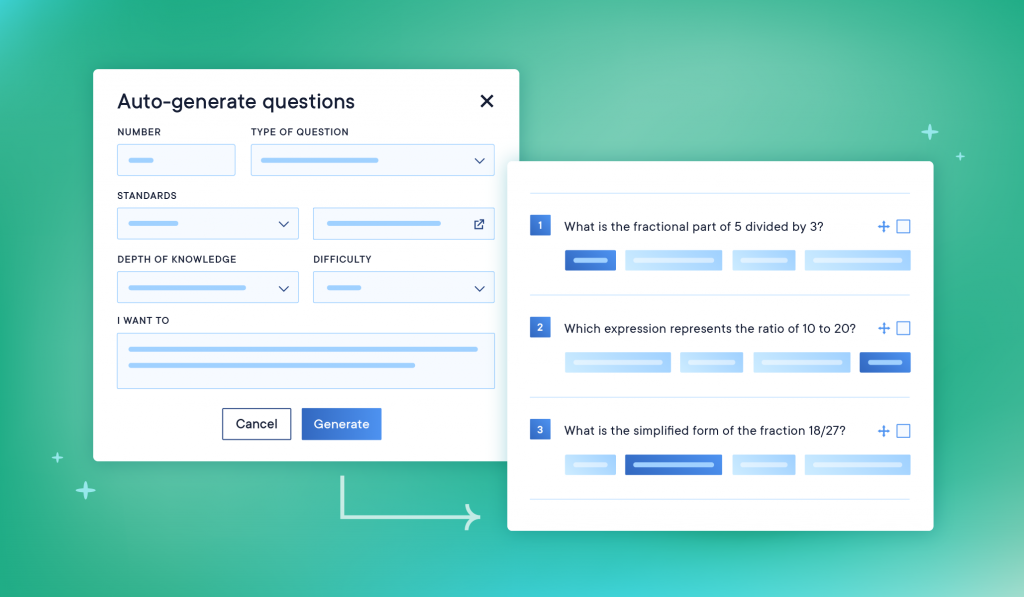Harness the Power of AI with Pear Assessment's Question Generator and Assisted Rubric

At Pear Assessment (formerly Edulastic), our mission has always been to empower teachers with innovative tools that enhance the education experience for every student. We believe in the transformative power of learning, and we're thrilled to unveil two brand-new features that harness the power of generative AI to augment and accelerate teachers’ current administrative workflows for building and grading assessments: Question Generator and Assisted Rubrics.
What is Question Generator?

We understand crafting assessments that align with state standards while considering depth of knowledge and difficulty level can be a time-consuming task. The Question Generator feature offers a prompt modal that includes state standards selector, depth of knowledge (DOK), and difficulty level options. Teachers can review and edit questions before including them in assignments or tests, ensuring assessments are perfectly tailored to their teaching objectives.
How to use Question Generator
You can start generating questions for your next assignment or quiz in Pear Assessment by following these simple steps:
- Create a test. When you log into Pear Assessment, go to “Test” on your left-hand navigation. Here, you have a few options for building quizzes, assignments, or tests: you can either build a test from scratch, or if you want to build a video-based quiz, select “Video Quiz.” For practice, select the “Create a quick test using AI” button and then name the test.
- Build your prompt. In the modal, declare how many items, the item format, and which grade and subject questions should be generated for. Optional fields include which standard, Depth of Knowledge, and Difficulty level you’d like questions to be built around. An additional open text field is also included to further guide the model on generating questions. While these are optional fields, the more information you provide, the more targeted your results will be.
- Review & adjust. Click the “Generate” button. The model will read your prompt and generate questions aligned to your input. A confirmation message will appear once the items are generated. Be sure to review each question for accuracy and alignment to what you’re intending to assess. Individual questions can be re-generated with a click from the preview window.
Once satisfied with your questions, you can continue configuring your test settings and publish.
“The quality of the questions created by the generator was fantastic and aligned perfectly with the selected standards. The possibilities for this tool are endless."
Amanda Hilt, 5th and 6th grade literature teacher, Illinois
What are Assisted Rubrics?

Rubrics are a proven and effective way to assess and provide feedback on essays or written response questions. However, many teachers shy away from using them due to the time required to create and grade using rubrics. With Assisted Rubrics, teachers can now generate standards and grade-aligned rubrics with ease, saving valuable time.
Additionally, Assisted Rubrics can also support the grading process, enabling teachers to generate AI-suggested scores and feedback for student essays based on the provided rubric. This not only expedites the grading process, but also provides teachers with a valuable starting point for grades and responses. Teachers can personalize and adjust scores and feedback before returning them to students.
By simplifying the rubric creation process, we're empowering teachers to provide more comprehensive feedback and improve student writing skills without the time-consuming hassle.
How to use Assisted Rubrics to generate a rubric:
- Create an essay question. In the Item bank, create a new essay question under the Writing item type. Check the box next to Grading Rubric as a scoring option. Then click “Create New Rubric” to open the rubric modal.
- Generate Rubric. In the rubric modal, name the rubric and add an optional description. Select the Auto-Generate Rubric button.
- Review & adjust. A rubric with criteria and ratings will be generated. Click the Preview button to review rubric and make any corrections to fit your needs.
How to grade essay questions with Assisted Rubrics:
- Build your assessment. Start by building an assessment in Pear Assessment. Add essay questions to the assessment and enable grading by rubric in the item’s settings.
- Configure your test settings. In the Test settings section, toggle Enable auto evaluation by AI under Student Tools, then assign the test.
- Review & adjust. As students submit their tests, scores and rationale for essay questions will populate. All scores and student feedback can be adjusted prior to accepting the score and sharing with the student.
How does the AI work?
Using AI in Pear Assessment can be distilled down to a few simple steps:
- Start by providing the input, whether explaining the types of questions you’d like to create or the rubric you’d like to use for grading within Pear Assessment.
- Pear Assessment combines your input with our uniquely developed academic content and student centered guardrails to make an anonymized “call” to a trained AI model.
- The model returns the results within Pear Assessment based on your input and the context Pear Assessment provides.
Our AI journey is just beginning.
We believe there are many exciting applications for our AI technology to empower educators and admins during assessment and feedback processes, and unlock new avenues to support students in ways we never thought possible.
Individual, school, and district accounts can purchase these capabilities within the Subscription settings page. Not already using Pear Assessment? Start your free Teacher Premium trial, or get in touch with our team about bringing Pear Assessment to your school or district.
.png)


